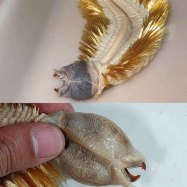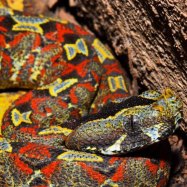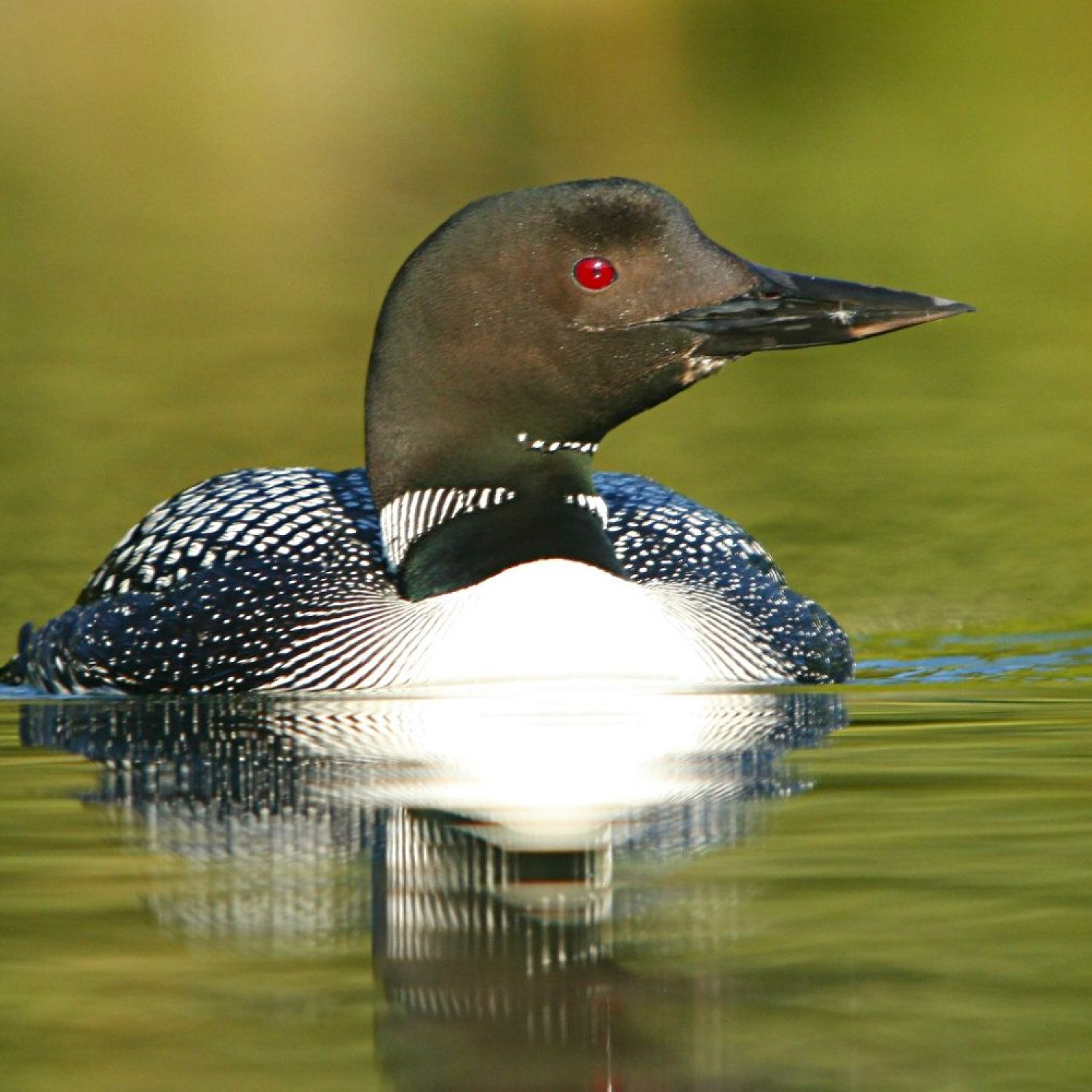
Common Loon
28 to 36 inches
The Common Loon, also known as the Great Northern Diver, is a large and streamlined bird found in the northern regions of North America and Eurasia. With a length of 28 to 36 inches, this iconic bird is known for its haunting call and distinctive black and white plumage. Belonging to the Gaviidae family, the Common Loon is a symbol of wilderness and a must-see for any bird enthusiast.
Animal Details Summary:
Common Name: Common Loon
Kingdom: Animalia
Habitat: Freshwater lakes, ponds, and rivers
The Graceful Diver: Exploring the Fascinating World of the Common Loon
As the sun rises over the tranquil waters of a freshwater lake, a haunting, eerie call pierces through the stillness of the morning. It is a sound that echoes through the forests and across the water, a call that has become synonymous with the wilderness of the northern regions of North America and Eurasia. This is the call of the Common Loon, a majestic and enchanting bird that has captured the hearts of many with its graceful movements and haunting vocalizations.Before delving deeper into the world of the Common Loon, let us first explore the basic facts about this fascinating creature Common Loon. Scientifically known as Gavia immer, the Common Loon belongs to the Animalia kingdom, Chordata phylum, Aves class, and Gaviiformes order. It is a member of the Gaviidae family, which includes only five living species of loons. The Common Loon is the most widespread and abundant species among them.
Often referred to as the "Great Northern Diver," the Common Loon lives in a variety of habitats, primarily in freshwater lakes, ponds, and rivers. They can also be found in coastal waters during their migration. They are highly territorial birds and tend to remain in one area throughout their lives, as long as the habitat remains suitable for their needs.
One of the most distinctive features of the Common Loon is its black and white coloration. Their head, neck, and underparts are white, while their back, wings, and tail are jet black. The black and white coloration is broken by a striking, vertical white stripe on their throat Cockalier. This unique marking is often referred to as the "necklace," and it is used to distinguish between individuals, much like human fingerprints.
Another notable physical characteristic of the Common Loon is its large and streamlined body shape. They are between 28 to 36 inches in length, with a wingspan of 48 to 56 inches. Despite their seemingly heavy body, they are exceptional avian divers, with a body density that makes them almost neutral in buoyancy. This makes them perfectly designed for life in the water.
Being carnivorous birds, Common Loons feed on a variety of aquatic prey, including fish, crustaceans, insects, and mollusks. Their feeding method is both fascinating and impressive, as they dive into the water with powerful strokes of their webbed feet, using their wings to propel themselves underwater. They can dive to depths of up to 200 feet and remain submerged for over a minute, making them one of the most accomplished divers in the animal kingdom.
Now that we have covered the basics, let us delve deeper into the world of the Common Loon and discover what makes this bird so unique and captivating.
The Enchanting Call of the Loon
One of the most iconic features of the Common Loon is its haunting vocalizations. Their calls are the epitome of the wilderness, often featured in movies and TV shows as the quintessential sound of the great outdoors. However, there is much more to their calls than just their haunting sound.Common Loons have four distinct calls, each with its own meaning and purpose. The most recognized call is the wail, a long, haunting sound that can travel for miles across the water. This call is mostly used to communicate with other loons, whether it is a warning of danger or a call to find a mate.
The second call is the tremolo, a rapid, stuttering sound that is often described as a laugh. This call is used as a warning signal and is usually heard when the loons feel threatened or agitated. It is also used during territorial disputes, where it acts as a declaration of dominance.
The third call is the yodel, which is reserved for male loons during mating season as they defend their territory from rival males. It is a series of short, rising notes that build in intensity and often end in a long, loud, and high-pitched note. It is considered one of the most beautiful and complex vocalizations in the bird world.
Lastly, there is the hoot, a softer and shorter version of the wail. It is the most commonly heard call during the day, as loons use it to communicate with their mate or offspring. It is also used as a contact call when loons are separated from each other. The hoot is often heard during the evening and early morning when the loons are most active.
The loon's vocalizations, combined with their mysterious and elusive nature, have given rise to various folklore and beliefs surrounding them. In some Native American cultures, they are seen as messengers between the spirit world and the living, and their calls are believed to bring messages from beyond. In Scottish folklore, loons were said to carry their deceased mate on their back to their final resting place, hence their scientific name Gavia immer, which means "immerse" or "dive under" in Latin.
A Unique and Special Bond
One of the most interesting behaviors of the Common Loon is their unique and special bond with their mate. They are monogamous birds, meaning they mate for life, and their bond is not just limited to breeding season. They stay together year-round, sharing the responsibilities of raising their young and working together to defend their territory.The courtship ritual of loons is a sight to behold. It usually begins with the male displaying his strength and prowess in the water, diving and surfacing with various objects, such as rocks and sticks, to impress the female. Once the female accepts the male, they perform a "mate dance," where they swim towards each other and lift their heads, displaying their necklaces. They also engage in coordinated swimming and diving, a display of their synchronized partnership.
After mating, the female lays two eggs, which both parents take turns incubating. After about a month, the chicks hatch, and the parents work together to care for and protect them. Common Loon chicks are covered in dark brown downy feathers, making them less visible to predators in the water. They ride on the backs of their parents for the first few weeks of their life and are often seen hitching a ride on their parents' backs until they are old enough to swim and dive on their own.
The strong bond between the loon parents transcends even after the chicks have fledged and left the nest. During the winter, the loons migrate to coastal waters, and often, they end up in the same area as their offspring from previous years. Studies have shown that these family groups tend to stay in close proximity to each other, further emphasizing the close and unique bond between Common Loon family members.
The Importance of Conservation
Common Loons have faced many challenges over the years, primarily due to human activities. Habitat loss, water pollution, disturbance from boat traffic, and ingestion of fishing gear and other human-made debris, have all contributed to the decline of this magnificent species. More recently, climate change has also become a significant threat to them, as it alters the timing of their migration and breeding patterns.However, there is hope for the future of the Common Loon. Thanks to conservation efforts and stricter regulations on the use of lead fishing tackle, the population of Common Loons has been slowly recovering. It is also crucial for humans to continue to respect the loon's habitat and reduce disturbances, such as loud noises and bright lights, during their breeding season.
One of the best ways to help preserve the Common Loon is to support organizations that work towards their conservation. Many wildlife and conservation organizations offer opportunities for people to get involved, whether it is through volunteering, fundraising, or spreading awareness about the importance of protecting these beautiful birds.
In Conclusion
The Common Loon is undoubtedly one of the most fascinating and enchanting creatures of the northern regions of North America and Eurasia. From their haunting vocalizations to their unique and special bond with their mate, these birds continue to captivate and intrigue those lucky enough to witness them in the wild.However, beyond their beauty and grace, the Common Loon serves as a reminder of the delicate balance of nature and the importance of conservation. As humans, it is our responsibility to coexist peacefully with the natural world and do our part in preserving it for generations to come. So next time you hear the call of the loon, take a moment to appreciate the beauty and wonder that surrounds them, and remember to do your best to protect these majestic birds.

Common Loon
Animal Details Common Loon - Scientific Name: Gavia immer
- Category: Animals C
- Scientific Name: Gavia immer
- Common Name: Common Loon
- Kingdom: Animalia
- Phylum: Chordata
- Class: Aves
- Order: Gaviiformes
- Family: Gaviidae
- Habitat: Freshwater lakes, ponds, and rivers
- Feeding Method: Carnivorous
- Geographical Distribution: North America and Eurasia
- Country of Origin: Canada
- Location: Northern regions of North America and Eurasia
- Animal Coloration: Black and white
- Body Shape: Large and streamlined
- Length: 28 to 36 inches
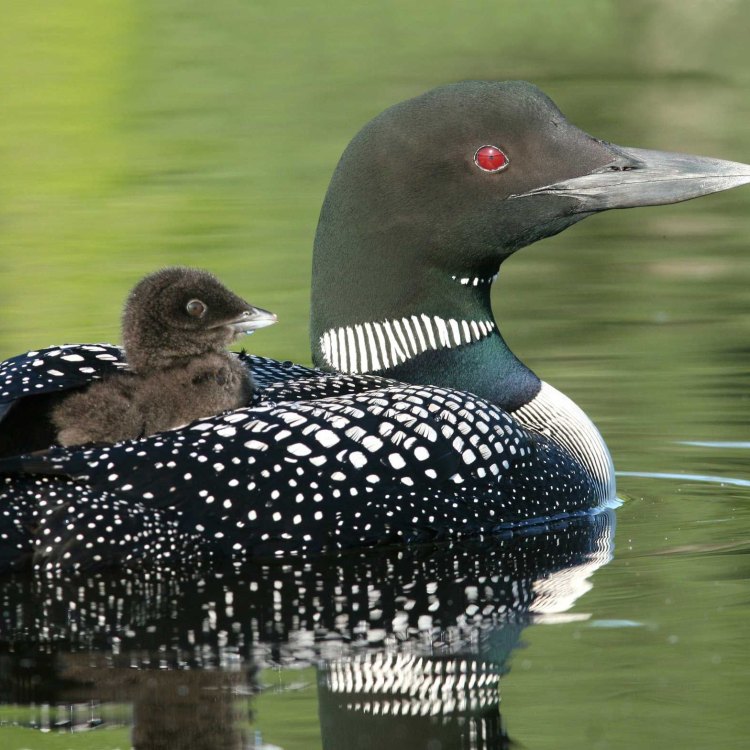
Common Loon
- Adult Size: Large
- Average Lifespan: 30 years
- Reproduction: Sexual
- Reproductive Behavior: Monogamous
- Sound or Call: Mournful wail
- Migration Pattern: Migratory
- Social Groups: Solitary or in small groups
- Behavior: Excellent swimming and diving abilities
- Threats: Habitat loss, pollution, fishing gear entanglement
- Conservation Status: Least Concern
- Impact on Ecosystem: Top predator, helps maintain fish population balance
- Human Use: Fishing, bird-watching
- Distinctive Features: Red eyes, black and white checkered back, dagger-like bill
- Interesting Facts: Known for their haunting calls and their ability to dive deep underwater
- Predator: Bald Eagle, Northern Pike
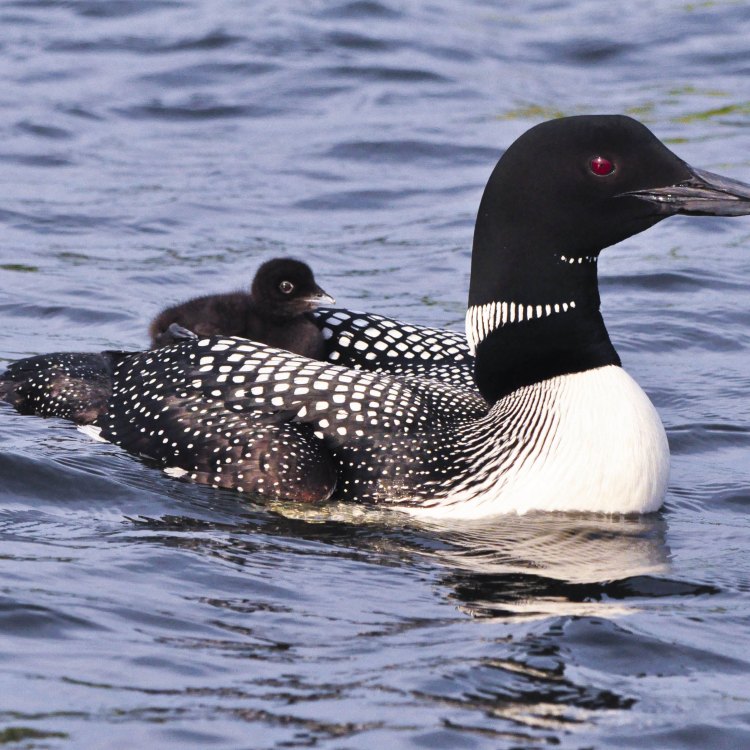
Gavia immer
The Fascinating Life of the Common Loon: A Master of the Northern Lakes
The Common Loon, also known as the Great Northern Diver, is a magnificent waterbird that is found in the Northern parts of North America and Eurasia. Its scientific name, Gavia immer, means "waterbird that dives." And that is exactly what this bird is known for - its excellent swimming and diving abilities. But what makes this bird truly special is not just its physical capabilities, but also its unique features and behaviors that contribute to its vital role in the ecosystem PeaceOfAnimals.Com. In this article, we will take a closer look at the fascinating life of the Common Loon and why it is considered a master of the Northern lakes.The Basics: Size, Lifespan, and Reproduction
The Common Loon is a large bird with adults ranging from 66-91 cm in length, a wingspan of 122-152 cm, and a weight of 2.5-6 kg. This makes it one of the largest diving birds in North America. With its distinctive black and white checkered back, white underparts, and long black neck, it is a unique and striking bird to behold.
But what is even more impressive is its average lifespan. While most birds have a lifespan of 2-3 years, the Common Loon has an average lifespan of 30 years. This is due to its exceptional adaptability and resilience in its environment.
As for reproduction, the Common Loon follows a sexual and monogamous reproductive behavior Crucian Carp. This means that they mate for life, with each pair returning to the same nesting area every year. This commitment to their partner is just one of the many admirable qualities of this magnificent bird.
The Mournful Wail: Sound or Call
One of the most distinctive features of the Common Loon is its mournful wail. Its haunting call can be heard echoing across the Northern lakes, earning it the nickname "the voice of the North." This call is not only beautiful, but it also serves as a way for mates to communicate with each other and to defend their territory. The unique sound and meaning of the Common Loon's call is a testament to its incredible communication skills.
But it's not just their call that sets them apart. Common Loons are also known for their various vocalizations, including yodels, hoots, and tremolos, which they use in different situations. For instance, they may yodel when flying or hoot when alarmed. All in all, their vocal range is not only impressive, but it also plays a vital role in their survival and reproduction.
Migratory Birds: A Journey Across Continents
Common Loons are migratory birds, meaning they travel long distances between their summer breeding grounds and wintering areas. They can be found as far north as the Arctic and as far south as Florida and Mexico during the winter. This long journey is not easy, and it requires a lot of energy and skill to navigate through different weather conditions and landscapes.
During migration, Common Loons travel in flocks, with each bird taking turns leading the pack. This strategic behavior allows them to conserve energy and increase their chances of survival. These intelligent birds also follow known flyways, flying over water bodies where they can rest and feed.
While their migration patterns may vary from year to year, one thing is for sure - the Common Loon's incredible journey is a marvel to behold.
Solitary or Social: The Behavior of the Common Loon
Common Loons are solitary birds for most of the year, with each pair only coming together during the mating season. This behavior is necessary for their survival and the survival of their offspring. However, during migration and in certain feeding areas, they may gather in small groups. This social behavior not only allows them to find food more efficiently, but it also serves as a form of protection from predators.
But it is their behavior in the water that truly sets them apart. The Common Loon is a master swimmer and diver, with its streamlined body, webbed feet, and powerful wings making it perfect for life in the water. They can dive up to 200 feet deep and stay underwater for several minutes in search of food. Their excellent swimming and diving abilities make them top predators in their environment, and their diet consists mainly of fish, crustaceans, and aquatic insects.
Threats to the Common Loon
Despite their remarkable capabilities, Common Loons face numerous threats in their natural habitat. Habitat loss due to human activities, including the destruction of wetlands and pollution, is one of the most significant threats to their survival. This loss of habitat not only affects their nesting and feeding areas but also disrupts their migration patterns.
Another threat to the Common Loon is fishing gear entanglement. Unfortunately, as these birds dive underwater to catch their prey, they can become entangled in fishing nets and lines, leading to injury or death. This is a significant concern for conservationists, as these birds are a vital part of the ecosystem.
Conservation Status and Impact on the Ecosystem
Fortunately, the International Union for Conservation of Nature (IUCN) has listed the Common Loon as "Least Concern" on the Red List of Threatened Species. This is because there are still relatively healthy populations of this bird, and there are ongoing efforts to protect and conserve their habitats.
As top predators, Common Loons play a crucial role in maintaining the balance of fish populations in their environment. By keeping fish populations in check, they help to prevent overpopulation, which can have significant impacts on the ecosystem. Without these birds, there would be a decrease in the diversity and abundance of aquatic species, disrupting the delicate balance of the ecosystem.
Human Use: A Source of Appreciation and Threat
The Common Loon has been a significant part of human culture for centuries. Indigenous cultures have long revered this bird, with many tribes considering it to be a sacred animal. In modern times, the Common Loon has become a popular bird-watching attraction, with its striking appearance and unique behaviors captivating people from all over the world. It is also a source of income for many, as bird-watching tours and fishing activities often rely on the presence of these magnificent birds.
However, human use of their environment also poses a significant threat to the Common Loon. As human activities continue to impact their habitats, it is essential that we take steps to protect and preserve these birds, not just for our own enjoyment but for the health of the ecosystem as a whole.
Distinctive Features: What Makes the Common Loon Unique?
Aside from their excellent swimming and diving abilities, the Common Loon has several distinctive features that make them stand out. These include their red eyes, which are striking against their black-and-white plumage. Their dagger-like bill is also unique, perfectly adapted for catching prey underwater. But perhaps the most notable feature of the Common Loon is their haunting call, which has become synonymous with the Northern lakes.
Interesting Facts: More Than Just a Beautiful Bird
Aside from their unique features and behaviors, there are many fascinating facts about the Common Loon that make it an exceptional bird. For instance, did you know that these birds can spend hours at a time preening and arranging their feathers? Or that they can swallow small stones that they use to help digest their food? They are also known for their courtship displays, where they engage in "dancing" on the water surface, showcasing their graceful movements.
However, the most interesting fact about the Common Loon is their ability to dive deep underwater. While other birds like the cormorants and puffins can also dive, the Common Loon's depth and duration of diving far surpass them. As they hunt for prey, they can reach depths of up to 200 feet and stay underwater for over a minute. This remarkable feat is what truly makes them masters of the Northern lakes.
Predators: A Constant Threat for the Common Loon
Despite their impressive abilities, Common Loons are not invincible. They face threats from predators, both on land and in the water. On land, their nests can be preyed upon by predators like raccoons and foxes, leading to loss of eggs or chicks. In the water, their main predators are the Bald Eagle and Northern Pike, both of which are skilled hunters and pose a constant threat to the Common Loon's survival.
The Importance of Protecting the Common Loon
The Common Loon is more than just a beautiful bird with impressive abilities. It is a vital part of the Northern lake ecosystems and plays a crucial role in maintaining the balance of its environment. As humans, it is our responsibility to protect and conserve these birds and their habitats, not just for their sake, but for the sake of the entire ecosystem.
By preserving wetlands, reducing pollution, and monitoring fishing practices, we can ensure that the Common Loon continues to thrive in its natural habitat. And as we appreciate the beauty and uniqueness of this magnificent bird, let us also remember its importance in maintaining the delicate balance of the Northern lakes.
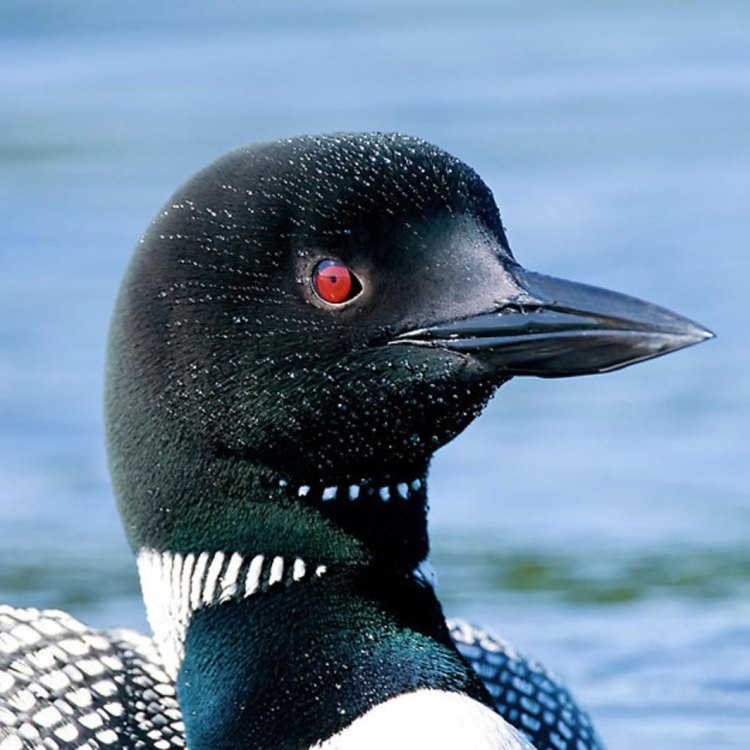
The Graceful Diver: Exploring the Fascinating World of the Common Loon
Disclaimer: The content provided is for informational purposes only. We cannot guarantee the accuracy of the information on this page 100%. All information provided here may change without prior notice.





